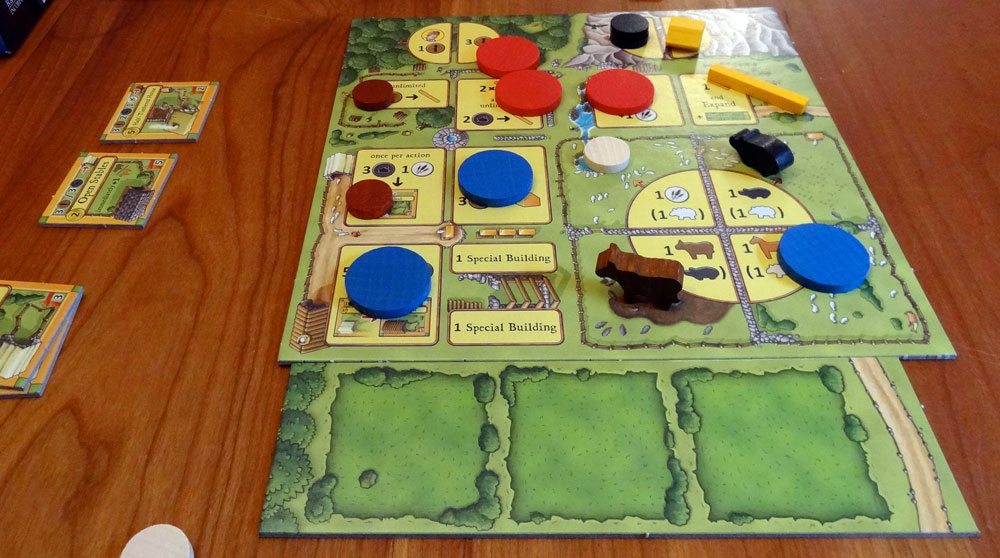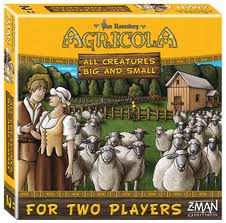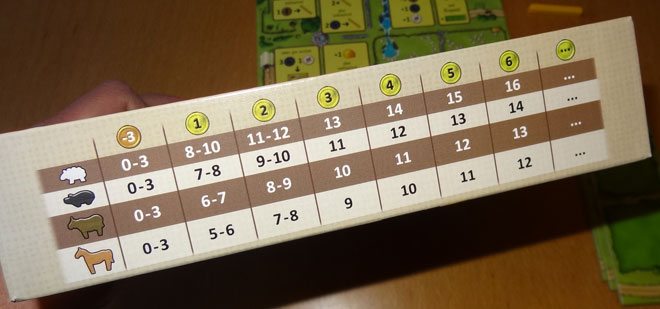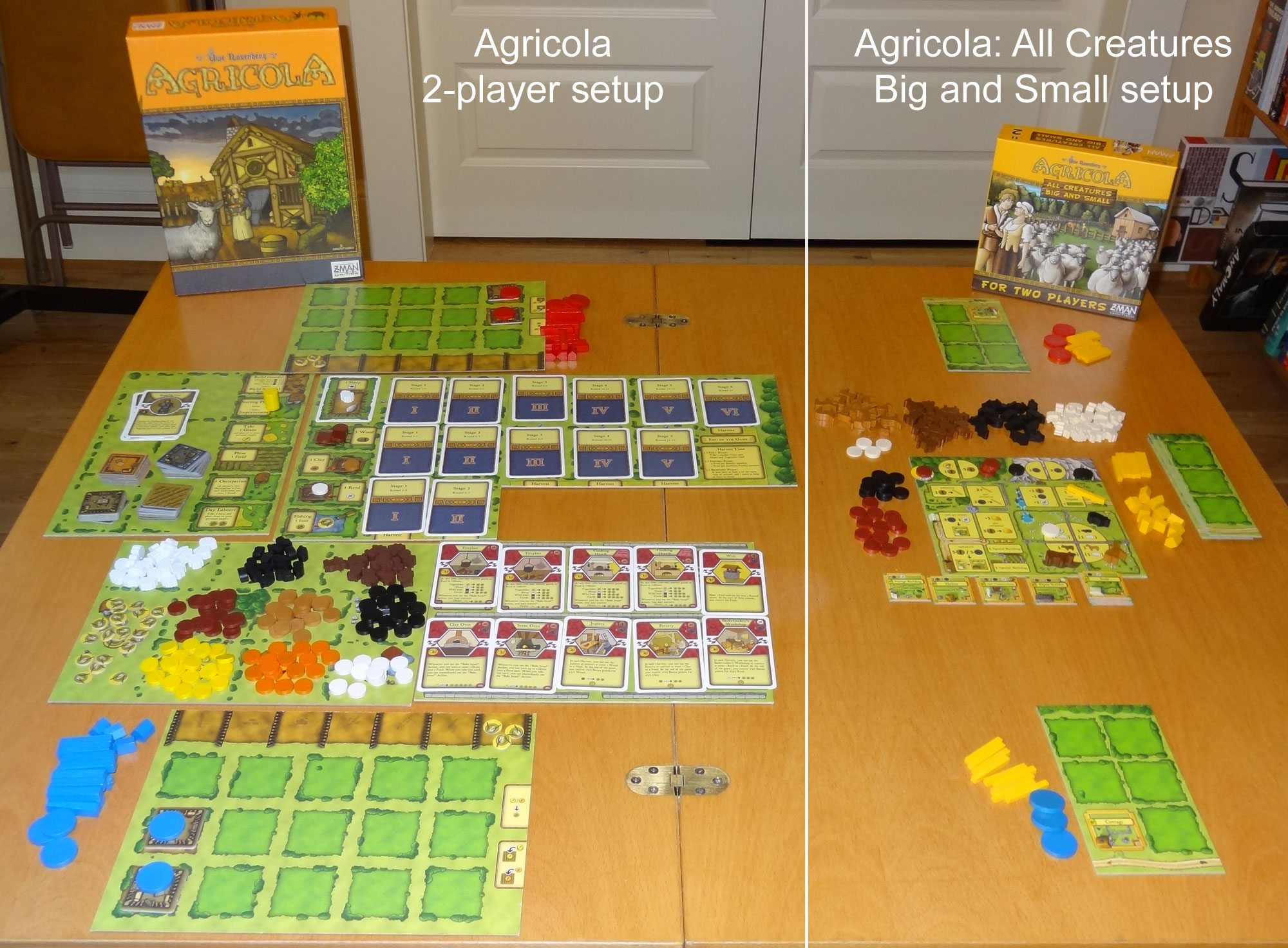
Table for Two is a series focusing on two-player board games. Today’s topic is Agricola: All Creatures Big and Small, a pint-sized version of the big worker-placement game. A version of this article was originally published a year ago.
 Overview: Agricola is a fantastic worker-placement game (one of my favorites, in fact) about farming, but it’s big and complex and can take hours to play. Agricola: All Creatures Big and Small is a compact version for two players that captures much of the feel of the original but in about half an hour. Fence pastures, build feeding troughs and buildings, and raise as many animals as you can! It’s for two players, ages 13 and up, and takes about half an hour to play. Retail price is $40.
Overview: Agricola is a fantastic worker-placement game (one of my favorites, in fact) about farming, but it’s big and complex and can take hours to play. Agricola: All Creatures Big and Small is a compact version for two players that captures much of the feel of the original but in about half an hour. Fence pastures, build feeding troughs and buildings, and raise as many animals as you can! It’s for two players, ages 13 and up, and takes about half an hour to play. Retail price is $40.
Theme:
Like the original, Agricola: All Creatures is based on 17th-century farming, so it’s fairly primitive technology. No GPS-driven combines here. In this version, you’re basically a rancher: you enclose pastures, build stalls, and raise animals. No plowing and planting, no expanding your own family or house, and only a few special buildings to keep track of.
The mechanics can be a little abstracted, but the idea is that you each have a few workers that you can send out to do particular tasks: gather resources like wood or stone, build fences and buildings, or gather animals. This last one is the most problematic, thematically: where are they getting these animals? They look like they just take them from a little fenced in area. Maybe they’re buying them at a market, or maybe your “workers” are really a bunch of crooks. “Sure, master, I’ll go fetch some more sheep today. I know a guy…”
Really, though, once you start playing, you really get into the idea of making your own little farm just right, planning out where you want buildings and fences and troughs, and figuring out where to house all of the animals you’ve acquired by – ahem – completely legitimate means.

Components:
Cardboard components:
- 1 game board
- 2 farm boards
- 4 farm expansions
- 4 double-sided stall/stable tiles
- 4 special building tiles
- 9 goods tiles
- 1 start player tile
Wooden components:
- 6 worker discs (3 in each color)
- 26 fence borders
- 22 sheep
- 16 pigs
- 13 cows
- 14 horses
- 17 wood tokens
- 15 stone tokens
- 5 reed tokens
- 10 yellow feeding troughs
Plus there’s a score pad and two little resealable plastic bags for all the bits.
The components look a lot like those from Agricola: the illustrations and icons are fairly well-designed so that even before you read the rules you can recognize that the little yellow bars match the yellow wooden borders, and so on. There are fun little details in the background of the game board that make it look like a large farm, with tiny animals walking around and areas where you collect various resources — it’s a nice touch that is unobtrusive and doesn’t get in the way of legibility of the board itself. The cardboard bits are nice, sturdy cardboard but nothing really fancy, and the wooden bits are nice, particularly the animals.

The one really odd decision is that the scoring for the game is split in two places. Most of the scoring explanation is on the back page of the rulebook, but there’s a chart for figuring out bonus points for animals that is only printed on the sides of the box. It’s strange to me that this chart isn’t included on the rulebook itself or on the score pad or even a reference card. I’ll probably copy down the chart on a card and just slip it in the box, so that during gameplay I can just refer to a card rather than picking up the box.
Gameplay:
The object of the game is to have the most points at the end of eight rounds. You earn points for the number of animals you have, filling up farm expansions, and buildings you’ve built.
To set up, each player gets a farm board, three worker discs, and 9 of the yellow borders. Then you place the game board in the center of the table, with everything else nearby in a supply. Pick a player to be starting player and give them the starting player tile.
Each round, there are four phases: Refill, Work, Home, Breeding.
During Refill, you look for the places on the board that have a little arrow on them, and you add the relevant goods to that space. (For instance, on the mountain section of the board, you’ll add 1 stone on one side and 2 stone on the other.) These will be added even if nobody took them the previous round, which means they’ll accumulate over time.
Work is when you take turns sending your workers out to do things. Place one of your workers on a space on the game board, and immediately take the associated action. Some spaces allow you to take goods (resources, animals, fences, etc.), some let you expand your farm or build things (as long as you have the right resources to pay for them). One space also lets you take the starting player tile for the next round. But each space can only hold one worker, so once that spot has been taken, nobody else can take that same action until the following round.
Home is when you collect all your workers off the game board and put them back near your farm.
Breeding, of course, is when your animals can breed. If you have at least two of a type of animal, then you can add one more to your farm — but you can only get one more of each type of animal. (These are very regulated animals; even if you have a dozen sheep, only one new lamb will be born each round.)
There are specific rules for how many animals you can keep and where you can keep them. Some buildings can house a specific number of animals; fenced pastures can hold two animals per space, and feeding troughs double that, but you have to segregate your animals by type. Animals can be moved around on your farm as needed, but anything that has been built has to stay put. If at any time you acquire more animals (whether from the game board or through breeding) but you don’t have room for it, then it just runs away and you discard it back to the supply.
After eight rounds of play, you calculate your score. First, you get one point for every animal you have, and points for any buildings you’ve built (each building has a point value on it). For farm expansions, you get 4 points if you’ve used all three spaces on them in some way — enclosing it, or building something on it.
Finally, you get bonus points for the animals by referring to that chart on the side of the box: you lose points if you have three or fewer of any type of animal, and you get bonus points for having a bunch of the same type. For example, it takes 8 sheep to get the first bonus point, but only 5 horses. The more you have of a particular type of animal, the more bonus points you may score.
Whoever has the most points wins; in case of a tie, the player who wasn’t starting player in the last round wins.

Conclusion:
As I’ve said before, the original Agricola remains one of my favorites: there are so many paths to get points, but you don’t have time (or enough workers) to get to all of them. However, as much as I like it, I don’t get it out that often because of the time commitment. Just getting it out and setting it up for the photo above, and then putting it all away, took nearly as long as it would to play an entire game of Agricola: All Creatures. And that’s for a two-player game. Once you add in three more players, then you’ve got additional action cards and another hour or two of play time.
Playing the slimmed-down Agricola: All Creatures feels similar, despite the fact that fields and planting are completely gone in favor of the animal husbandry. But let’s face it: little wooden animals are much cuter than wooden vegetables. When I wrote about Zooloretto Mini, another compact adaptation of a larger game, I noted that it felt like what the original game should have been in the first place. Not so with Agricola: All Creatures — I’ll definitely be keeping the original for when I have more time and players and want the full experience, but now I have an excellent alternative when time is tight and I’ve just got one person to play with.
So what is it that makes Agricola and its miniature version so great?
Partly it’s the theme: building out your farm, taking control over a little plot of land and deciding where to put things is just plain fun (cf. Farmville). But it’s also the way the theme makes sense of the mechanics: you only have so many workers, and they can only do so much each round. If they’re out chopping wood, then they can’t also be building fences. If you don’t build a fence around the pasture, you can’t keep animals there because they’ll wander off. Things seem to make sense.
It’s also the limitations that the game places on you: because you only have so many rounds and so many workers, you can’t do everything. You can raise a few of each animal, but then you may not get the bonus points for having, say, a whole bunch of pigs. But if you don’t get the minimum of 4 of each type of animal, it’ll cost you points. So do you make up for that by building some great buildings or expanding your farm? Or do you go after all those animals, and skimp on the building? Much of this will also be determined by what your opponent is doing, because if they take all the cows, then you’ll just have to find some other way to make up those lost points.
Finally, I like the way the scoring works — but this may because I’m a min-maxer. I like the challenge of figuring out how to maximize my scoring with the opportunities left on the board: taking those sheep might get me those bonus points (plus the extra sheep during breeding), but how does that compare to the three points I’ll lose by not having enough horses? What’s the best way to get the most bonus points, now that the other player took those fences I was counting on?
That said, this is a game where you’ll need to be able to do some quick arithmetic in your head while you play, or else you’ll be at a severe disadvantage. The mechanics of the game are easy enough for younger kids to learn, but without a good grasp of how the end-game scoring works, you don’t stand a chance. Folks who don’t care for on-the-fly calculation may like the theme but won’t appreciate the strategy.
My biggest complaint is, again, that scoring track on the side of the box. I realize that there aren’t any other cards in the box so it probably wasn’t cost-effective to put it on a reference card, but even having the chart reproduced on a page in the rulebook would have been nice. At $40 retail, it does feel expensive for a two-player game, particularly when compared to the full-sized Agricola. However, if you’re looking for a great, deep game for two, Agricola: All Creatures is worth a closer look. It’s also a great way to ease into Agricola itself, since many of the mechanics will carry over into the larger game.
The mini-expansion More Buildings Big and Small adds 27 new special buildings to the mix (plus an extra stall and farm expansion). I haven’t played with those yet, but I think I’ll hold off for now until I’ve gotten more plays of the base game under my belt. Still, it’s something to look forward to. (It is kind of funny to me, though, to add expansions to a mini version—will they all eventually add up back to the original Agricola?)
For more information, visit the Z-Man Games website.
Disclosure: Z-Man Games provided a review copy of this game.
